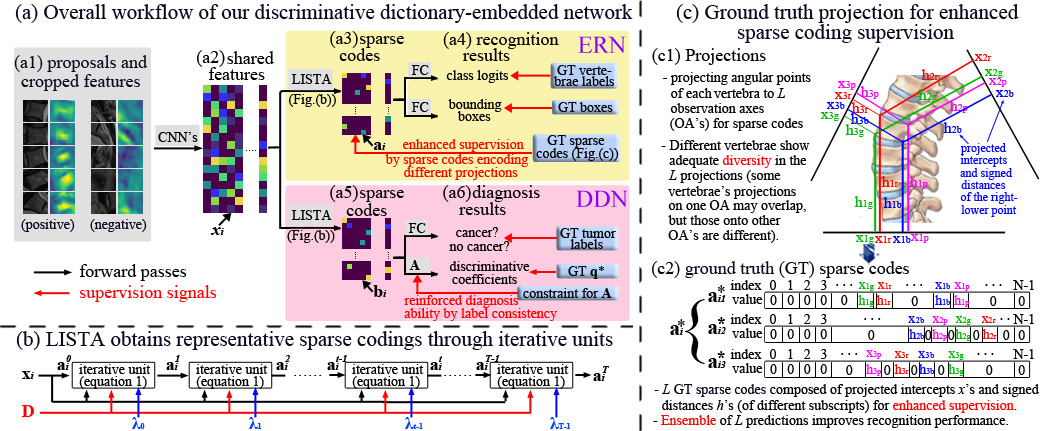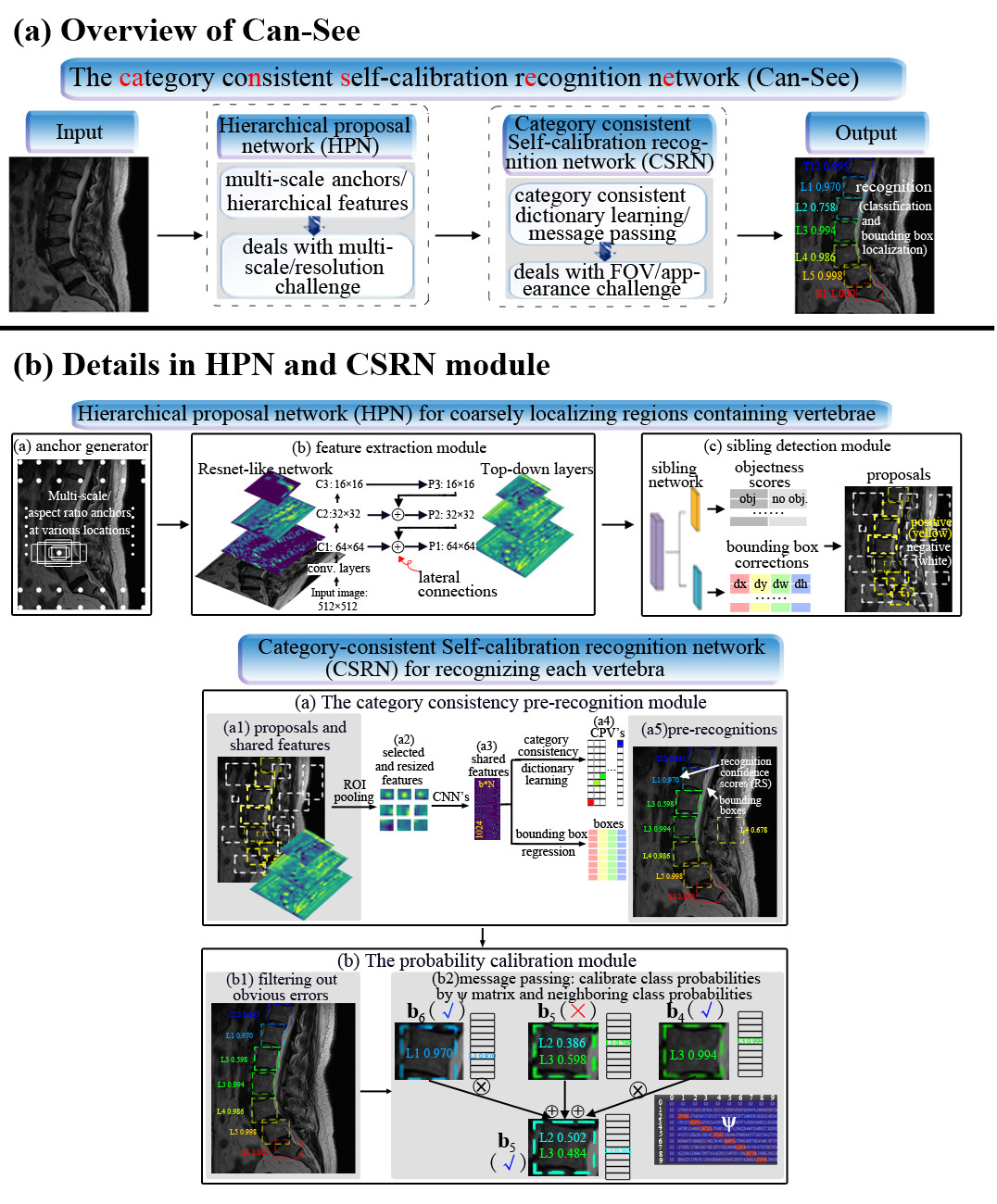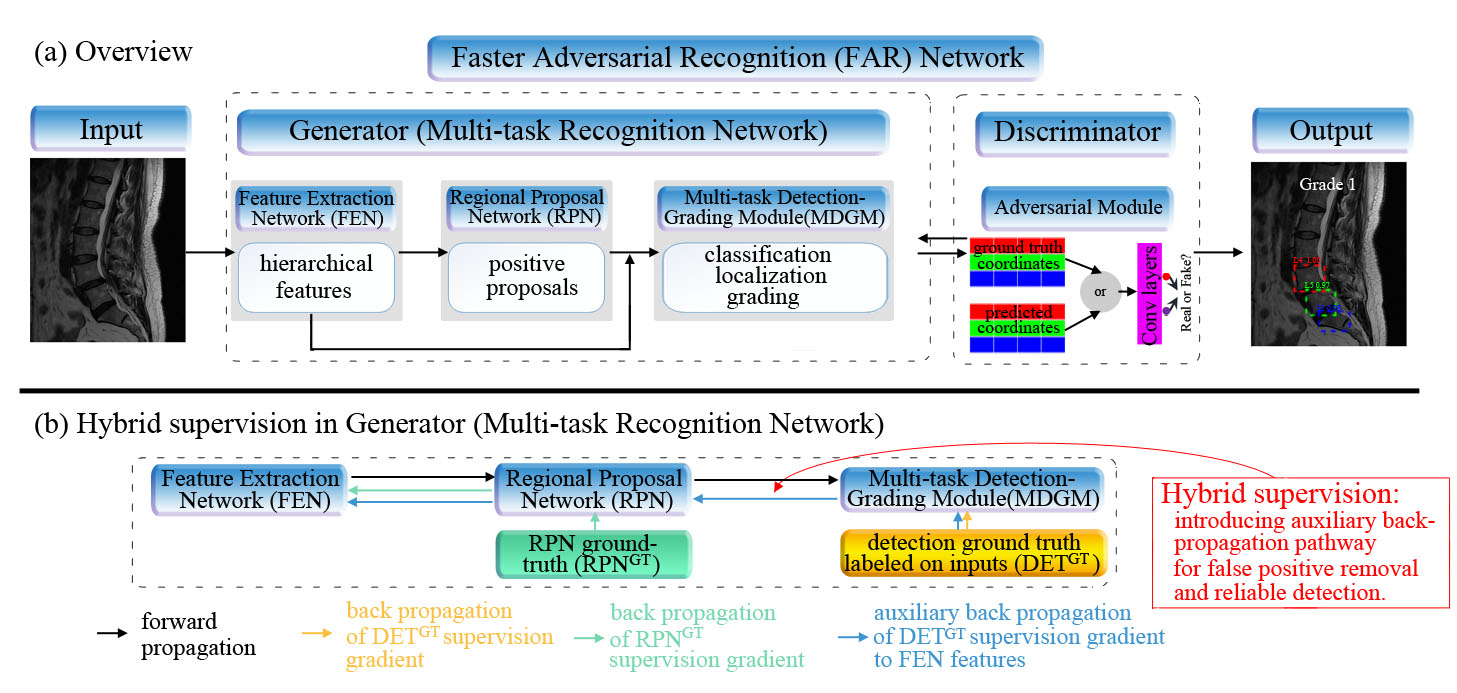Selected Publications
For a complete list, please check my
google scholar.
Codes for these papers will be uploaded to github in succession in the near future. Also,
I am very happy to
provide my codes in advance if you are interested in my papers for academic use.
【04】 Discriminative dictionary-embedded network for comprehensive vertebrae tumor
diagnosis.
Shen Zhao , Bin Chen, Heyou Chang, Xi Wu, and Shuo Li.
Medical Image Computing and Computer Assisted Intervention (MICCAI) 2020.

- Methodoloy innovations: Based on our previous work in MEDIA 2020 and
MICCAI 2019, we go further into dictionary learning in recognition task by using projection-guided dictionary
learning; also, we advance the recognition task to tumor diagnosis, a crucial clinical application for
treatment planning and metastasis preventation, by designing a label-consistent dictionary learning network.
This work could benefit other object recognition problems where the locations of the target objects are sparse
in the input image.
- Advantages: An heuristic exploration of leveraging sparse codes to encode different recognized
objects (vertebrae) for better distinguishability.
A compact end-to-end network for simultaneous vertebrae recognition and tumor diagnosis.
- Disadvantages: Not found yet.
【03】 Automatic Vertebrae Recognition from Arbitrary Spine MRI images by a
Category-Consistent Self-calibration Detection Framework.
Shen Zhao , Xi Wu, Bo Chen, and Shuo Li.
Medical image analysis (MEDIA) 2020.

- Methodoloy innovations: Based on our previous work published in MICCAI
2019, we go deeper to the principles of message passing to present a more profound understanding of how the
label compatibility matrix is trained and how it is used in the testing phase.
We also provide a preliminary attempt to use dictionary learning in deep CNN's by proposing a label-consistent
dictionary learning module and integrating it into the deep learning-based pre-recognition network.
- Advantages: An in-depth understanding of message passing, dictionary learning, as well as the RPN
networks for object detection.
- Disadvantages: The dictionary learning method is only a preliminary attempt, and the k-sparse
auto-encoder is somewhat simple.
【02】 Automatic Vertebrae Recognition from Arbitrary Spine MRI Images by a Hierarchical
Self-calibration Detection Framework.
Shen Zhao , Xi Wu, Bo Chen, and Shuo Li.
Medical Image Computing and Computer Assisted Intervention (MICCAI) 2019.

- Methodoloy innovations: For the first time, message passing is
formulated into deep learning object recognition network for self-awareness and self-calibration of wrong
recognition results of an object detection network.
This work could benefit other object recognition problems where the locations of the target objects have some
certain internal spatial relationships.
- Advantages: An efficient way of leveraging the label relationships of different recognized
objects (vertebrae) for errors in object recognition networks.
An in-depth understanding of the two-stage object recognition networks.
- Disadvantages: Not found yet.
【01】 Automatic spondylolisthesis grading from MRIs across modalities using faster
adversarial
recognition network.
Shen Zhao , Xi Wu, Bo Chen, and Shuo Li.
Medical image analysis (MEDIA) 2019.

- This is the first paper that I use deep learning-based methods for medical
image analysis.
- Methodoloy innovations: A multi-task detection-diagnosis network has been constructed for
simultaneous human organ (vertebrae) recognition and disease (spondylolisthesis) diagnosis.
Adversarial networks are attempted to be used in recognition networks. Hybrid supervision is introduced to
provide stronger supervision signals to the proceeding network.
- Advantages: Accurate recognition of critical vertebrae (which tends to suffer from
spondylolisthesis), and precise diagnosis of the disease.
- Disadvantages: As my research goes deeper, I find that the adversarial module and the auxiliary
path for gradient back-propagation may be substituted by more efficient methods.
【00】 Robust Segmentation of Intima-Media Borders with Different Morphologies and Dynamics
During
the Cardiac Cycle.
Shen Zhao , Zhifan Gao, Heye Zhang, Yaoqin Xie, et.al.
IEEE Journal of Biomedical and Health Informatics (JBHI) 2017.

- This is the first paper after I entered medical image analysis domain!
- Methodoloy innovations: A robust grayscale-derivative constraint snake algorithm that avoids
sudden change of grayscale and derivative at IM border points between consecutive frames.
- Advantages: Fast and robust segmentation of IM borders in ultrasound sequences with noises,
large movements between frames, different IM appearances, and plagues.
- Potential clinical usage: Diagnosis of cardiovascular diseases not only by IMT but also by its
changes during the cardiac cycle.
- Disadvantages: Snake parameters are still based on manual experience.
- Codes
are available for this paper.





